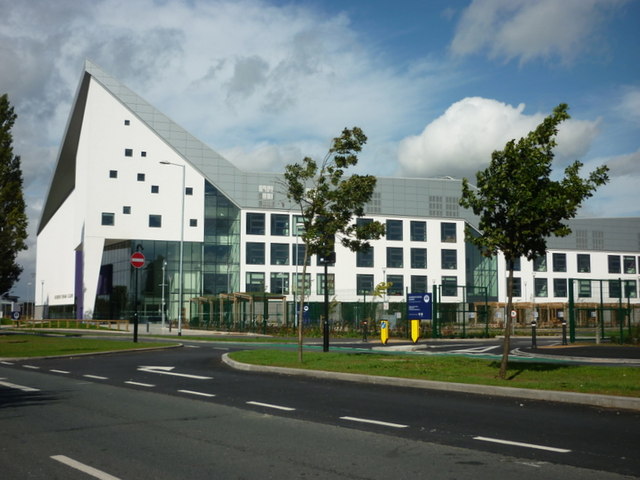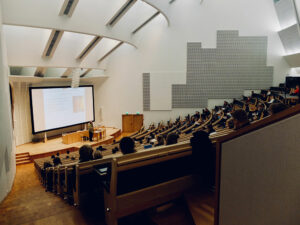
The Schools of Tomorrow

School networks are being forced to change and adapt faster than ever. They must accept not only today’s future technology, but also prepare for the future’s future technology. But since we don’t know exactly what the future holds, how are schools supposed to prepare? What is IT supposed to take into account when designing next generation networks?
There are three macro trends developing today: an increasing number of devices per student; increasing IoT devices; and, cloud services. Let’s take a brief look at each trend to see what IT is up against.
Devices Per Student
Not that long ago it was common for schools to have one, or maybe two, computer labs. Then computers were added to individual classrooms. Then students got smartphones. Then students and schools got tablets. Do you see where this is going? Combining this 1:1 trend with the IoT trend makes it obvious that many schools find themselves growing beyond 1:1 even today. What will happen three years from now?
Increasing IoT Devices
Where to start? IoT is exploding and there is no reason to expect that will stop. Currently, in schools these devices cover everything from thermostats and security systems to interactive whiteboards and eBooks. 75% of teachers believe digital learning content will completely replace printed textbooks by 2026. Some schools have added wirelessly connected smart plugs or solar panels for energy-saving purposes. The options for IoT seem endless, and IT must determine how much of that new technology will find its way into schools.
Cloud Services
Everyone loves the cloud, but what purpose does it serve in education? As it turns out, there isn’t only one answer. The cloud can be used to give students and teachers access to homework assignments; it can reduce the costs of on-site storage and software licenses; cloud applications can transform lesson plans, and the options go on and on. As digital learning grows, the options for including cloud services in every-day education will also grow. The global ed-tech market is expected to reach $93.76 billion by 2020.
It used to take centuries for technology to evolve. Then that changed to decades, and then years. Now, technology changes every day. For each macro trend there are hundreds of thousands of new applications, new e-learning initiatives, and new opportunities for network growth, not to mention other trends not mentioned here. Some changes are easy to see coming. For example, the new WiFi standard 802.11ax will likely have a huge presence in schools over the next few years. But what about inventions like Augmented Reality or Virtual Reality? Or new technologies no one can even imagine? How are schools supposed to prepare?
One of the best ways to prepare for the future is to study what happened in the past, and what is currently happening on the network. To do this IT needs two things: absolute visibility into a school’s wired and wireless systems, and predictive analytics.
Visibility
With visibility, IT knows exactly how many devices and what kinds of devices are connected to the network, and what they do on the network. Visibility also provides data on how device types, kinds, and behavior have changed from the past to the present. This provides a crucial and necessary baseline that is needed before any accurate predictions can be made about future network dependencies. Visibility becomes especially important with new technologies entering the mix every day, sometimes without IT’s prior knowledge. Whether this is because a student brings a new device to school, or because the school itself adds new technology, complete visibility can be a game changer.
Predictive Analytics
Predictive analytics works in two ways. One, it analyzes a network and can alert IT if degradation or other issues seem likely. Two, because of this analysis and proactive response, it keeps a network optimized. This is particularly helpful when it might not be immediately obvious how new and old technologies will interact.
Bringing It All Together
So, where can schools find this technology? In a WiFi analytics platform. These platforms monitor and optimize a wireless network and should, of course, offer complete visibility and predictive analytics. In addition, schools should look for platforms with the following capabilities:
Automatic and Proactive – the entire platform should be automatic, so that it runs even when IT is not on the clock, and proactive, so that it solves potential problems before they cause network downtime.
A Robust Network Test Suite – networks are an ever-evolving ecosystem consisting of hardware, software, and devices. Platforms should provide automatic tests that routinely screen every part of the network and report any issues.
Device Recognition – this partners with complete visibility. It is the ability to identify network devices, and determine when new devices are added to a network and how they are operating.
Historical Analytics – platforms that store historical data analytics can provide information on how the network has changed. This information is useful for budget and network capacity planning.
Pro Tip: Vendor Agnostic – search for a platform that is vendor agnostic. This means the platform will always work, even if a school changes network vendors.
With these tools, schools are equipped to optimize current networks, and future-proof against rapidly advancing technology changes. Bring on the future. You’re ready for it.

